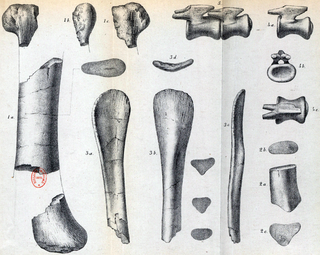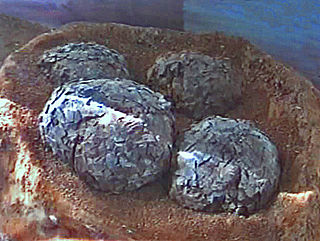
An eggshell is the outer covering of a hard-shelled egg and of some forms of eggs with soft outer coats.

Hypselosaurus is a dubious genus of titanosaurian sauropod that lived in southern France during the Late Cretaceous, approximately 70 million years ago in the early Maastrichtian. Hypselosaurus was first described in 1846, but was not formally named until 1869, when Phillip Matheron named it under the binomial Hypselosaurus priscus. The holotype specimen includes a partial hindlimb and a pair of caudal vertebrae, and two eggshell fragments were found alongside these bones. Because of the proximity of these eggshells to the fossil remains, many later authors, including Matheron and Paul Gervais, have assigned several eggs from the same region of France all to Hypselosaurus, although the variation and differences between these eggs suggest that they do not all belong to the same taxon. Hypselosaurus has been found in the same formation as the dromaeosaurids Variraptor and Pyroraptor, the ornithopod Rhabdodon, and the ankylosaurian Rhodanosaurus, as well as indeterminate bones from other groups.

Dinosaur eggs are the organic vessels in which a dinosaur embryo develops. When the first scientifically documented remains of non-avian dinosaurs were being described in England during the 1820s, it was presumed that dinosaurs had laid eggs because they were reptiles. In 1859, the first scientifically documented dinosaur egg fossils were discovered in France by Jean-Jacques Poech, although they were mistaken for giant bird eggs.

Elongatoolithus is an oogenus of dinosaur eggs found in the Late Cretaceous formations of China and Mongolia. Like other elongatoolithids, they were laid by small theropods, and were cared for and incubated by their parents until hatching. They are often found in nests arranged in multiple layers of concentric rings. As its name suggests, Elongatoolithus was a highly elongated form of egg. It is historically significant for being among the first fossil eggs given a parataxonomic name.

Diepkloof Rock Shelter is a rock shelter in Western Cape, South Africa in which has been found some of the earliest evidence of the human use of symbols, in the form of patterns engraved upon ostrich eggshell water containers. These date around 60,000 years ago.

Cairanoolithus is an oogenus of dinosaur egg which is found in Southwestern Europe. The eggs are large and spherical. Their outer surface is either smooth, or covered with a subdued pattern of ridges interspersed with pits and grooves. Multiple fossil egg clutches are known but the nest structure is unclear.

Megaloolithus is an oogenus of dinosaur egg. Some eggs belonging to this oogenus may have been laid by the titanosaur Hypselosaurus. They are known for having thick eggshells, at least 1.5 millimetres (0.059 in) thick, and the nearly spherical shape of the eggs. They are primarily found in India and Europe, but some specimens have been found in South America.
Sphaerovum is an oogenus of dinosaur egg that has only been discovered in South America.

Macroolithus is an oogenus of dinosaur egg belonging to the oofamily Elongatoolithidae. The type oospecies, M. rugustus, was originally described under the now-defunct oogenus name Oolithes. Three other oospecies are known: M. yaotunensis, M. mutabilis, and M. lashuyuanensis. They are relatively large, elongated eggs with a two-layered eggshell. Their nests consist of large, concentric rings of paired eggs. There is evidence of blue-green pigmentation in its shell, which may have helped camouflage the nests.
Continuoolithus is an oogenus of dinosaur egg found in the late Cretaceous of North America. It is most commonly known from the late Campanian of Alberta and Montana, but specimens have also been found dating to the older Santonian and the younger Maastrichtian. It was laid by an unknown type of theropod. These small eggs are similar to the eggs of oviraptorid dinosaurs, but have a distinctive type of ornamentation.
Ageroolithus is an oogenus of dinosaur egg. It may have been laid by a theropod.
Dispersituberoolithus is an oogenus of fossil egg, which may have been laid by a bird or non-avian theropod.

Egg fossils are the fossilized remains of eggs laid by ancient animals. As evidence of the physiological processes of an animal, egg fossils are considered a type of trace fossil. Under rare circumstances a fossil egg may preserve the remains of the once-developing embryo inside, in which case it also contains body fossils. A wide variety of different animal groups laid eggs that are now preserved in the fossil record beginning in the Paleozoic. Examples include invertebrates like ammonoids as well as vertebrates like fishes, possible amphibians, and reptiles. The latter group includes the many dinosaur eggs that have been recovered from Mesozoic strata. Since the organism responsible for laying any given egg fossil is frequently unknown, scientists classify eggs using a parallel system of taxonomy separate from but modeled after the Linnaean system. This "parataxonomy" is called veterovata.

Egg taphonomy is the study of the decomposition and fossilization of eggs. The processes of egg taphonomy begin when the egg either hatches or dies. Eggshell fragments are robust and can often travel great distances before burial. More complete egg specimens gradually begin to fill with sediment, which hardens as minerals precipitate out of water percolating through pores or cracks in the shell. Throughout the fossilization process the calcium carbonate composing the eggshell generally remains unchanged, allowing scientists to study its original structure. However, egg fossils buried under sediments at great depth can be subjected to heat, pressure and chemical processes that can alter the structure of its shell through a process called diagenesis.
Tipoolithus is an oogenus of fossil egg native to the Irbzer Formation in Morocco. Its classification is uncertain, but it most closely resembles Laevisoolithids, and like members of that oofamily, it was laid by an enantiornithine bird or small theropod.
Mycomorphoolithus is an oogenus of fossil eggs found in Spain and England. They possibly represent eggshells of non-eusuchian crocodylomorphs, and are similar to, but not part of, the Krokolithidae.
Guegoolithus is an oogenus of fossil egg from the early Cretaceous of Spain. It is classified in the oofamily Spheroolithidae, and was probably laid by an ornithopod dinosaur.
Polyclonoolithus is an oogenus of fossil dinosaur egg. It is from the Early Cretaceous of Gansu, China. They have distinctive, branching eggshell units, which may represent the original form of spheroolithids.
Incognitoolithus is an oogenus of medioolithid fossil bird egg. It is notable for bearing evidence of predation, possibly from a bird pecking the eggshell.
Nanhsiungoolithus is an oogenus of dinosaur egg from the late Cretaceous of China. It belongs to the oofamily Elongatoolithidae, which means that it was probably laid by an oviraptorosaur, though so far no skeletal remains have been discovered in association with Nanhsiungoolithus. The oogenus contains only a single described oospecies, N. chuetienensis. It is fairly rare, only being know from two partially preserved nests and a few eggshell fragments.








